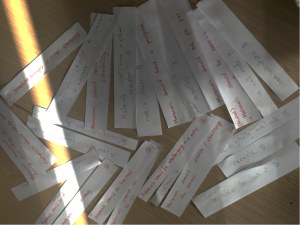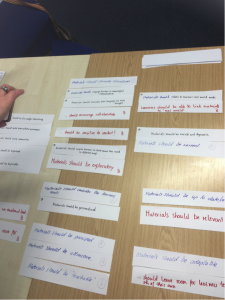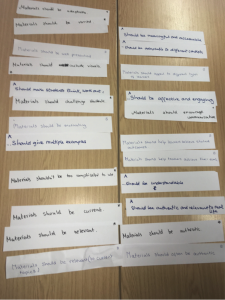I have to admit that I’ve never previously sat down to consider the principles I follow/refer to/put into practice when I’m creating materials, or how I (would) do it. Although many coursebook writers describe the creative process as being
- intuitive
- based on experience
- inspiration
- chaotic
- recursive
- ad hoc
- spontaneous
(and I would tend to agree with them on some of those points), Jill Hadfield (2014) finds that experienced materials writers have “a ‘tacit’ framework of principles underlying their design decisions which can be called into play at any moment, depending on the demands of the task.”
Though I wouldn’t wish to equate myself to the experienced writers Hadfield refers to or in Johnson’s study (2003), I see some similarities with my own process:
- the first stage is painful – thinking of an initial idea is hard!
- sometimes it just doesn’t work and you have to start again from scratch. I find this quite frustrating so I wouldn’t however describe this as ‘easy abandonment capacity’ just yet, but at the end of the day you want materials that work well and achieve their aims – what’s the point in keeping something that isn’t useful even if you have spent hours on it?
I also find myself asking some of the same questions Hadfield (2014) describes as her own tacit principles:
- Does the activity achieve the aim in the best possible way?
- Is the staging in the best logical sequence?
- Does staging scaffold the students by providing achievable steps? – I find this one to be especially in EAP as activities often involve integrating an approach to a task that students would later be required to complete on their own, so thinking this part through carefully means that the lesson can be a 2-for-1 deal on content/language and exam/skill technique.
- Is there variety and balance of interaction?
I also tend to imagine how it’s going to play out in the classroom, how I’m going to introduce the activities, manage the students or offer them extra support etc. This also involves completing the activity myself normally a day or 2 after creating the materials so I can see them with fresh eyes (that is if it isn’t a last minute job of course!). I also find talking through my plan with a colleague (dialoguing) really helpful – getting another perspective is great when you might be trapped in your own head, and can’t take enough of a step back to see a major flaw in the design or an small addition or different application/interpretation that would make the materials even better.
I’m not sure how useful I’d find sitting with a checklist during this process. I’m fairly certain I’d hate it and find it restrictive. Although frameworks offer useful guidance as to considerations during the creative process, I wonder whether the checks described above (more of an evaluation) are more helpful and easier to implement. Perhaps by bearing these thoughts and principles in mind when creating materials, it has the same or similar effect.
Our principles
It was interesting to discover that a lot of the principles I hold as a teacher are shared with my classmates. Perhaps this isn’t particularly surprising since we’ve all chosen to further our knowledge of our profession by taking the course, but considering we’re from wide-ranging backgrounds around the world (with home countries of Italy, Argentina, Japan, Kuwait, Angola, the UK, plus experiences living and working in other countries) it’s interesting to note this overlap.

Our group’s principles – look at how many similarities there are even though we’d written them on our own!
Materials should (my ideas in 5 mins):
- have flexibility
- have a purpose
- be fit for purpose
- stretch and challenge the learner
- not be so boring/dry that they dissuade learners from learning
- be relevant to learners
- be well laid out and clear
Additionally based on our discussions, materials should:
- be digitally available – perhaps I take this for granted? Yes, we have coursebooks, but we also have a wealth of digital in house materials on file.
- be culturally acceptable – I think this one is a little more open for me than for some of my coursemates teaching abroad in terms of topics that can be covered because students also have to integrate British society and because I have mixed-nationality classes. Obviously they are introduced in as objective a manner as possible so as not to offend, and with focus more on making students (more) aware. I guess my favourite question is ‘Is this the same in your country?’ to promote cultural awareness.
- be up to date – yes! I can’t believe I didn’t think of this one myself. In EAP and skills teaching ‘up to date’ might not mean the same as it does in EFL – fortunately I don’t come across the problem of having to explain what a cassette is to my class before teaching a lesson on ‘new technologies’ very often. I think the main issue related to this is that our coursebooks no longer fully reflect the assessments our students are going to take because of changes made to the curriculum.
- have instructions – yes and no. One criticisms of our in house coursebook is that the teachers’ notes are unhelpful, but when I make my own materials, I have it clear in my mind how they are going to be used so I don’t tend to write many instructions on the sheet given to students. A little hypocritical perhaps!
- Recycle – yes! Always a good idea.
- Be real world – yes please! This is fairly standard in EAP because there’s a very definite setting in which to base our lessons.
- Encourage creativity – this is a difficult one for EAP as there are so many academic conventions that need to be taught, understood and ultimately respected
- Be varied – yep.




